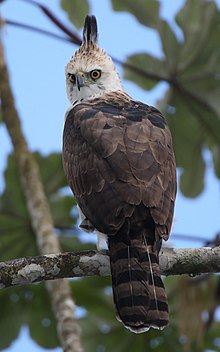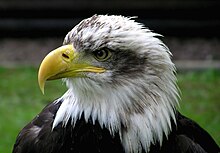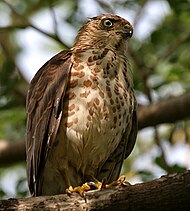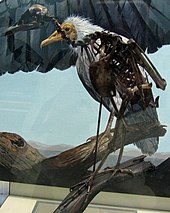Accipitridae
| Accipitridae Temporal range: Eocene - Recent | |
|---|---|
 | |
| Juvenile Ornate Hawk-eagle Spizaetus ornatus | |
| Scientific classification | |
| Kingdom: | Animalia |
| Phylum: | Chordata |
| Class: | Aves |
| Order: | Accipitriformes |
| Family: | Accipitridae Vieillot, 1816 |
| Subfamilies | |
The Accipitridae, one of the two major families within the order Accipitriformes (the diurnal birds of prey), are a family of small to large birds with strongly hooked bills and variable morphology based on diet. They feed on a range of prey items from insects to medium-sized mammals, with a number feeding on carrion and a few feeding on fruit. The Accipitridae have a cosmopolitan distribution, being found on all the world's continents (except Antarctica) and a number of oceanic island groups. Some species are migratory.
Many well-known birds, such as hawks, eagles, kites, harriers and Old World vultures are included in this group. The Osprey is usually placed in a separate family (Pandionidae), as is the Secretary bird (Sagittariidae), and the New World vultures are also usually now regarded as a separate family or order. Karyotype data indicated that the accipitrids hitherto analysed are indeed a distinct monophyletic group, but whether this group should be considered a family of the Falconiformes or one or several order(s) on their own is a matter of taste.
Systematics
The accipitrids have been variously divided into some 5–10 subfamilies. Most share a very similarmorphology, but many of these groups contain taxa which are more aberrant. These are placed in their respective position more for lack of better evidence than anything else. It is thus not very surprising that the phylogenetic layout of the accipitrids has always been a matter of dispute.
The accipitrids are recognizable by a peculiar rearrangement of their chromosomes. Apart from this, morphology and mtDNA cytochrome b sequence data gives a confusing picture of these birds' interrelationships. What can be said is that the hawks, kites, eagles and Old World vultures as presently assigned in all likelihood do not form monophyletic groups:
According to the molecular data, the Buteoninae are most likely poly- or paraphyletic, with the true eagles, the sea eagles, and the buteonine hawks apparently representing distinct lineages. These appear to form a group with the Milvinae, Accipitrinae and Circinae but the exact relationships between the lineages are not at all robustly resolvable with the present data. The Perninae and possibly the Elaninae are older lineages, as are the Old World vultures. The latter are fairly likely also poly- or paraphyletic, with some aberrant species like the Bearded and Egyptian Vulturesstanding apart from the naked-necked "true" vultures.
Morphology
The Accipitridae are a diverse family with a great deal of variation in size and shape. They range in size from the tiny Pearl Kite and Little Sparrowhawk, both of which are 23 cm (9 in) in length and weigh about 85 g (3 oz), to the Cinereous Vulture, which measures up to 120 cm (47 in) and weighs up to 14 kg (31 lbs). Until the 14th century even these were surpassed by the extinct Haast's Eagle of New Zealand, which is estimated to have measured up to 140 cm (55 in) and to have weighed 15 kg (33 lbs).In terms of body mass, Accipitridae is the most diverse family of birds. Most accipitrids exhibit sexual dimorphism in size, although unusually for birds it is the females that are larger than the males. This sexual difference in size is most pronounced in active species that hunt birds, such as Accipiter hawks, in which the size difference averages 25–50%. In a majority of species, such as generalist hunters and rodent, reptile, fish and insect hunting specialists, the dimorphism is less, usually between a 5% to 25% size difference. In the carrion-eating Old World vultures and snail eating kites, the difference is almost non-existent.
The beaks of accipitrids are strong, hooked (sometimes very hooked, as in the Hook-billed Kite or Snail Kite). In some species there is a notch or 'tooth' in the upper mandible. In all accipitrids the base of the upper mandible is covered by a fleshy membrane called the cere which is usually yellow in colour. The tarsi of different species vary by diet, those of bird hunting species like sparrowhawks are long and thin, while species that hunt large mammals have much thicker, stronger ones, and snake-eagle have thick scales to protect from bites.
The plumage of the Accipitridae can be striking but rarely utilises bright colours; most birds use combinations of grey, buff and brown.Overall they tend to be paler below, which helps them seem less conspicuous when seen from below. There is seldom sexual dimorphism in plumage, when it occurs the males are brighter or the females resemble juveniles. In many species juveniles have a distinctly different plumage. Some accipitrids mimic the plumage patterns of other hawks and eagles. They may attempt to resemble a less dangerous species to fool prey, or instead resemble a more dangerous species in order to reduce mobbing by other birds. Several species of accipitrid have crests used in signalling, and even species without crests can raise the feathers of the crown when alarmed or excited. In contrast most of theOld World vultures possess bare heads without feathers; this is thought to prevent soiling on the feathers and aid in thermoregulation.
The senses of the Accipitridae are adapted to hunting (or scavenging), and in particular their vision is legendary. The sight of some hawks and eagles is up to 8 times better than that of humans. Large eyes with two fovea provide binocular vision and a "hawk eye" for movement and distance judging. In addition they have the largest pectens of any birds. The eyes are tube shaped and cannot move much in their sockets. In addition to excellent vision many species have excellent hearing, but unlike in owls sight is generally the principal sense used for hunting. Hearing may be used to locate prey hidden in vegetation, but sight is still used to catch the prey. Like most birds the Accipitridae generally have a poor sense of smell; even the Old World vultures make no use of the sense, in contrast to the New World vultures in the familyCathartidae.
Diet and feeding
Accipitrids are predominately predators and most species actively hunt for their prey. Prey is usually captured and killed in the powerful talons of the raptor and then carried off to be torn apart with a hooked bill for eating or feeding to nestlings. A majority of accipitrids are opportunistic predators that will take any prey that they can kill. However, most have a preference for a certain type of prey which inharriers and the numerous buteonine hawks tends towards small mammals such as rodents. Raptors who favor small mammals usually soar or hover over openings until they detect their prey and descent down onto them, although they may also watch for prey from a perch. In Accipiter hawks (the most species-rich acciptrid genus), prey is mainly comprised by other birds. Accipiter hawks usually ambushed birds in dense vegetation, a dangerous hunting method that requires great agility. Most accipitrids will supplement their diet with non-putrid carrion but, of course, none specialized with this as well as the vultures.
A few species may opportunistically feed on fruit and in one species, the Palm-nut Vulture, it forms the major part of the diet. Most accipitrids will not eat plant material. Insects are taken exclusively by around 12 species, in great numbers by 44 additional species, and opportunistically by many others.The diet of the honey-buzzards includes not only the adults and young of social insects such as wasps and bees, but the honey and combs from their nests. The Snail Kite and Hook-billed Kites are specialists in consuming snails. "Eagles" are several raptors that are not necessarily closely related but can be broadly defined by large body size and the taking of typically larger prey, including mid-sized mammals and larger birds. Most accipitrids usually hunt prey rather smaller than themselves. However, many accipitrids have been recorded as capturing and then flying with prey of equal weight or even slightly heavier than themselves in their talons, a feat that requires great physical strength. Occasionally, an eagle or other raptor that kills prey considerably heavier than itself (too heavy for the raptor to carry and fly with) and will then have to leave prey where they've killed and later return repeatedly to feed. This has the advantage of providing a surplus of food but has the disadvantage of potentially attracting scavengers or other predators which can steal the kill or even attack the feeding accipitrid. Using this method, accipitrids such as the Golden, Martial and Crowned Eagle have successfully hunted deer andduikers weighing more than 30 kg (66 lb), 7-8 times their own mass. The Haliaeetus eagles, theIchthyophaga eagles and the Osprey mainly prefer to prey on fish (comprising more than 90% of food for the latter 2 genera). These large acciptrids may supplement their diets with aquatic animals other than fish, especially the more generalized Haliaeetus eagles. Reptiles are hunted by almost all variety of acciptrids when the opportunity arises and may even be favored over other prey by some eagles andbuteonine hawks found in the tropics. Bazas and forest hawks in the genus Accipiter may take reptiles from trees whilst other species may hunt them on the ground. Snake are the primary prey of the snake-eagles (Circaetus) and serpent-eagles (Spilornis and Dryotriorchis).
Genera
- Subfamily Elaninae - elanid kites (8 species)
- Genus Elanus
- Genus Chelictinia
- Genus Gampsonyx
- Genus Elanoides
- Subfamily Perninae - honey buzzards (c.14 species)
- Genus Aviceda
- Genus Henicopernis
- Genus Pernis
- Genus Leptodon
- Genus Chondrohierax
- Genus Machaerhamphus (Doubtfully placed)
- Subfamily Aegypiinae - Old World vultures
- Genus Sarcogyps
- Genus Aegypius
- Genus Torgos
- Genus Trigonoceps
- Genus Gyps
- Genus Necrosyrtes
- Subfamily Gypaetinae
- Genus Neophron
- Genus Gypohierax
- Genus Gypaetus
- Genus Eutriorchis
- Subfamily Buteoninae - buteonine hawks, true eagles and sea-eagles (c.100 living species, probably poly- or paraphyletic)
- Genus Geranoaetus
- Genus Buteo (probably paraphyletic, might include Leucopternis in part and Parabuteo)
- Genus Parabuteo
- Genus Buteogallus (probably paraphyletic, might include Leucopternis in part)
- Genus Busarellus
- Genus Leucopternis (probably polyphyletic)
- Genus Kaupifalco
- Genus Butastur
- Genus Harpyhaliaetus
- Genus Geranospiza
- Subfamily Aquilinae
- Genus Spizaetus
- Genus Nisaetus
- Genus Lophaetus (possibly junior synonym of Ictinaetus)
- Genus Stephanoaetus
- Genus Polemaetus
- Genus "Hieraaetus"
- Genus "Lophotriorchis"
- Genus Aquila (paraphyletic)
- Genus Ictinaetus
- Subfamily Circinae - harriers (some 16 living species)
- Genus Circus
- Subfamily Polyboroidinae - harrier hawks
- Genus Polyboroides
- Subfamily Milvinae - milvine kites (some 14 species)
- Genus Harpagus
- Genus Ictinia
- Genus Rostrhamus
- Genus Helicolestes - formerly included in Rostrhamus
- Genus Haliastur
- Genus Milvus
- Genus Lophoictinia
- Genus Hamirostra
- Subfamily Accipitrinae - goshawks, sparrowhawks, and relatives (c.55 living species)
- Genus Accipiter
- Genus Urotriorchis
- Genus Erythrotriorchis
- Genus Megatriorchis
- Subfamily Circaetinae - snake eagles (about one dozen species)
- Genus Terathopius
- Genus Circaetus
- Genus Spilornis
- Genus Pithecophaga
- Subfamily Haliaeetinae - sea eagles
- Genus Haliaeetus
- Genus Ichthyophaga
- Subfamily Harpiinae
- Genus Morphnus
- Genus Harpia
- Genus Harpyopsis
- Subfamily Melieraxinae
- Genus Melierax (Micronisus)
Fossil record
Like with most other birds of prey, the fossil record of this group is fairly decent[vague] from the latterEocene onwards (c.35 mya), with modern genera being well documented since the Early Oligocene, or around 30 mya.
- Milvoides (Late Eocene of England)
- Aquilavus (Late Eocene/Early Oligocene - Early Miocene of France)
- Palaeocircus (Late Eocene/Early Oligocene of France)
- Palaeastur (Agate Fossil Beds Early Miocene of Sioux County, USA)
- Pengana (Early Miocene of Riversleigh, Australia)
- Promilio (Agate Fossil Beds Early Miocene of Sioux County, USA)
- Proictinia (Early - Late Miocene/Early Pliocene of C and SE USA)
- Neophrontops (Early/middle Miocene - Late Pleistocene) - formerly in Neophron
- Mioaegypius (Xiacaowan middle Miocene of Sihong, China)
- Apatosagittarius (Late Miocene of Nebraska, USA)
- Gansugyps (Liushu Late Miocene of China)
- Palaeoborus (Miocene)
- Qiluornis (Miocene of Shandong, China)
- Thegornis (Miocene of Argentina)
- Garganoaetus (Early Pliocene of Gargano Peninsula, Italy)
- Amplibuteo (Late Pliocene of Peru - Late Pleistocene of S North America and Cuba) - may belong to extant genus Harpyhaliaetus
- Neogyps
- Palaeohierax - includes "Aquila" gervaisii
- Wetmoregyps - formerly Morphnus daggetti
Accipitrids are known since Early Eocene times, or about from 50 mya onwards, in fact, but these early remains are too fragmentary and/or basal to properly assign a place in the phylogeny. Likewise, as remarked above, molecular methods are of limited value in determining evolutionary relationships of and within the accipitrids. What can be determined is that in all probability, the group originated on either side of the Atlantic, which during that time was only 60-80% its present width. On the other hand, as evidenced by fossils like Pengana, some 25 mya, accipitrids in all likelihood rapidly acquired a global distribution - initially probably even extending to Antarctica.
- Accipitridae gen. et sp. indet. (Huerfano Early Eocene of Huerfano County, USA)
- Accipitridae gen. et sp. indet. (Borgloon Early Oligocene of Hoogbutsel, Belgium)
- Accipitridae gen. et sp. indet. (Bathans Early/Middle Miocene of Otago, New Zealand)
- Accipitridae gen. et sp. indet. MPEF-PV-2523 (Puerto Madryn Late Miocene of Estancia La Pastosa, Argentina)
- "Aquila" danana (Snake Creek Late Miocene/Early Pliocene of Loup Fork, USA) - formerly alsoGeranoaetus or Buteo
- Accipitridae gen. et sp. indet. (Early/Middle Pliocene of Kern County, USA) - Parabuteo?
- Accipitridae gen. et sp. indet. (Late Pliocene/Early Pleistocene of Ibiza, Mediterranean) - Buteo?
- Accipitridae gen. et sp. indet. (Egypt)
Specimen AMNH FR 2941, a left coracoid from the Late Eocene Irdin Manha Formation of Chimney Butte (Inner Mongolia) was initially assessed as a basal mid-sized "buteonine";it is today considered to be more likely to belong in the Gruiformes genus Eogrus. The Early Oligocene genus Cruschedula was formerly thought to belong to Spheniscidae, however reexamination of the holotype in 1943 resulted in the genus being placed in Accipitridae. Further examination in 1980 resulted in placement as Aves incertae sedis.






No comments:
Post a Comment